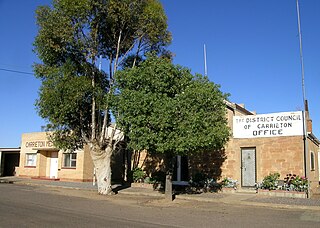
Northern Areas Council is a local government area in the Yorke and Mid North region of South Australia. The council seat and main council offices are at Jamestown, while the council also maintains district offices at Gladstone and Spalding.

Jamestown is a town in the Mid North region of South Australia 207 kilometres (129 mi) north of Adelaide. It lies on the banks of the Belalie Creek and on the Crystal Brook-Broken Hill railway line between Gladstone and Peterborough, and ultimately on the main line linking Adelaide and Perth to Sydney. At the 2016 census, Jamestown had a population of 1,561, and is the thriving centre of a prosperous area. Jamestown is the council seat of its local municipality, Northern Areas Council. Jamestown is in the South Australian Legislative Assembly electoral district of Stuart and the federal Division of Grey.
Charles Rufus Goode was a pastoralist and politician in the early days of South Australia.
Burra was an electoral district of the House of Assembly in the Australian state of South Australia from 1875 to 1902, and again from 1938 to 1970.
Gordon James Gilfillan was a pastoralist and politician in the State of South Australia.
The Times and Northern Advertiser was a weekly newspaper published in Peterborough, South Australia from August 1887 to 1970.

William Miller was an Australian politician who represented the South Australian House of Assembly multi-member seat of Burra Burra from 1902 to 1918. He represented the Farmers and Producers Political Union (1905–1910), the Liberal Union (1910–1918) and the Farmers and Settlers Association (1918).

The District Council of Orroroo was a local government area in South Australia, centred on the town of Orroroo. It was gazetted on 5 January 1888 under the provisions of the District Councils Act 1887 and included all the land defined by the hundreds of Black Rock Plain, Coomooroo, Erskine, Pekina, and Walloway in the County of Dalhousie.

The District Council of Carrieton was a local government area in South Australia, centred on the town of Carrieton from 1888 until 1997.

The District Council of Coglin was a local government area in South Australia. It came into operation on 5 January 1888 under the provisions of the District Councils Act 1887. At its inception, it comprised the Hundreds of Cavenagh, Coglin, Gumbowie, Parnaroo, Hardy, Nackara, and Paratoo. It was divided into four wards: Coglin, Gumbowie, East and North. Meetings were held alternately at Dawson and Lancelot until 1899, and thereafter at Penn.
The Corporate Town of Jamestown was a local government area in South Australia, centred on the town of Jamestown. It was proclaimed on 25 July 1878, severing the seven-year old settlement of Jamestown from the surrounding District Council of Belalie. The first mayor was John Cockburn, later Premier of South Australia, with George Hingston Lake as town clerk. Under the new council, it instituted a tree-planting program from 1879, reportedly the first town in rural South Australia to do so.

The District Council of Yongala was a local government area in South Australia from 1883 to 1935, seated at Yongala.
The District Council of Jamestown was a local government area in South Australia, centred on the region surrounding the town of Jamestown. The District Council came into existence on 21 March 1935 following the amalgamation of 95% of the District Council of Belalie with the District Council of Caltowie and the Hundred of Mannanarie, which had been in the abolished District Council of Yongala. For almost all of its history, it surrounded but did not include the town of Jamestown itself; the Jamestown township had separated from Belalie as the Corporate Town of Jamestown in 1878, and would not merge back into the broader municipality until 1991.
The District Council of Caltowie was a local government area in South Australia, centred on the town of Caltowie and surrounding cadastral Hundred of Caltowie. It came into operation on 28 February 1878, with the first five councillors appointed by proclamation. The town and hundred had both been laid out in 1872. The council initially met in local hotels, leased private offices for a period, and met at Hornsdale Station for a year, before constructing purpose-built council offices in Charles Street, Caltowie, in 1896.
The District Councils Act 1887 was an act of the Parliament of South Australia. It received assent on 9 December 1887, and its provisions came into effect when proclaimed by Governor William C. F. Robinson on 5 January 1888.

Belalie East is a rural locality in the Mid North region of South Australia. It is situated in the Northern Areas Council. The boundaries were formally established in April 2001 for the long established local name, relating to the cadastral Hundred of Belalie; however, the modern locality is divided between Belalie and the adjacent Hundred of Whyte.
The District Council of Neales was a local government area in South Australia from 1878 to 1932. The main town and council seat was Eudunda.

The District Council of Julia was a local government area in South Australia from 1874 to 1932. The council seat was located at Hampden.

The District Council of Terowie was a local government area in South Australia from 1888 to 1935, centring on the town of Terowie.

The Hundred of Belalie is a cadastral unit of hundred located in the Mid North of South Australia in the approach to the lower Flinders Ranges. It is one of the hundreds of the County of Victoria and its main town is Jamestown, South Australia. The Hundred corresponded to the former District Council of Belalie. The rural localities of Belalie North and Belalie East derive from the hundred.








